"Cherishing Little Steps - A Haven for Baby and Family Journeys"
Baby Shoes Walking
In the journey of a child’s development, the significance of proper footwear cannot be understated. Just as each step is a milestone, the shoes they wear play a crucial role in supporting their natural foot movement and promoting healthy growth.
This article aims to provide valuable insights into understanding baby foot development and selecting the right shoe size, materials, and features for walking. Additionally, it will address safety considerations and offer guidance on caring for baby shoes to ensure comfort and flexibility.
Key Takeaways
- Investing in high-quality shoes is important for the proper development of babies’ feet.
- Barefoot walking can aid in the development of balance and coordination.
- Proper shoe sizing and shoes that offer proper support are essential for babies’ foot development.
- Opt for shoes made of breathable materials like leather or mesh and regularly inspect baby’s feet for any signs of discomfort or skin issues.
The Importance of Proper Footwear
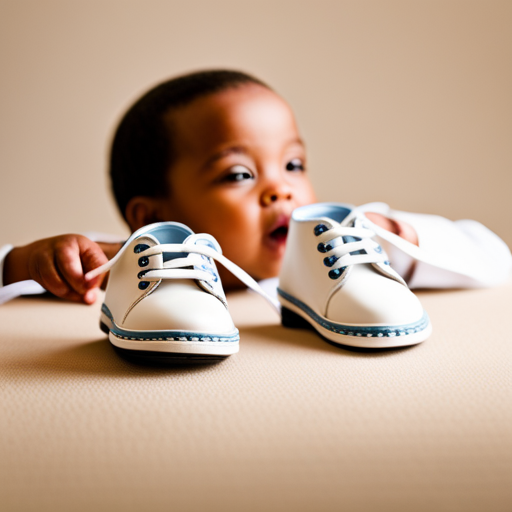
Undoubtedly, the proper footwear is crucial in maintaining the health and well-being of individuals, emphasizing the importance of investing in high-quality shoes. This is especially true when it comes to babies and their developing feet. As parents, it is essential to choose baby shoe brands that prioritize comfort and support.
One important consideration for baby shoes is the benefits of barefoot walking. Research has shown that allowing babies to walk barefoot can aid in the development of their balance and coordination. When babies walk barefoot, they can feel the ground beneath them, which helps to strengthen their foot muscles and promote proper alignment. Additionally, barefoot walking allows the toes to spread naturally, which can prevent issues such as toe deformities.
However, there are situations where shoes are necessary to protect the baby’s feet from potential hazards. In these cases, it is crucial to select shoes that provide proper arch support, flexibility, and breathability. High-quality baby shoe brands prioritize these features in their designs, ensuring that the shoes provide the necessary support without restricting the natural movement of the feet.
Understanding Baby Foot Development
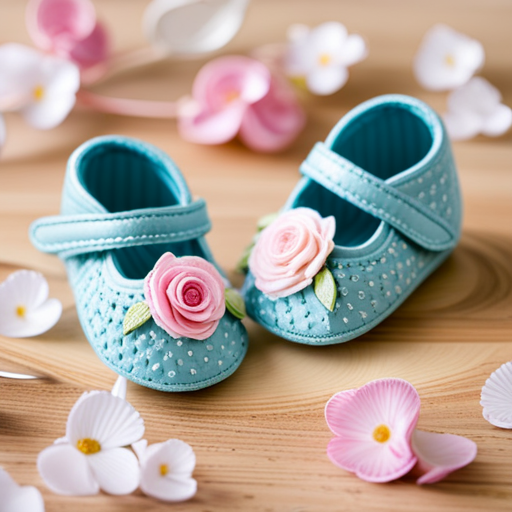
In order to fully comprehend the intricacies of baby foot development, it is crucial to consider the various factors that contribute to their overall foot health. Understanding baby shoe sizes and common foot problems can greatly assist parents and caregivers in providing the best care for their little ones. Here are four key points to consider:
-
Proper shoe sizing: Choosing the right shoe size for babies is essential for their foot development. Ill-fitting shoes can lead to discomfort, hinder proper growth, and even cause foot deformities. It is important to measure their feet regularly and select shoes that provide enough room for natural foot movement.
-
Supportive footwear: Babies’ feet are still developing, and they need shoes that offer proper support. Look for shoes with flexible soles, cushioned insoles, and good arch support to promote healthy foot development and prevent common foot problems like flat feet or pronation.
-
Breathability and materials: Opt for shoes made of breathable materials like leather or mesh to allow air circulation and prevent excessive sweating. Avoid synthetic materials that can trap moisture and lead to fungal infections.
-
Regular foot checks: It is crucial to inspect baby’s feet regularly for any signs of discomfort, redness, or skin issues. Early detection of common foot problems such as ingrown toenails, blisters, or calluses can prevent them from worsening and causing long-term issues.
Choosing the Right Shoe Size
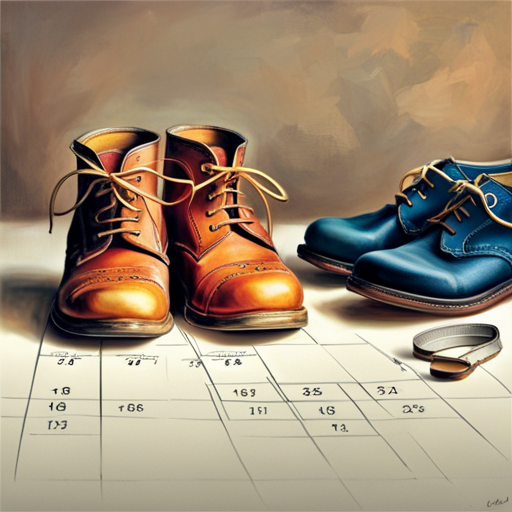
Parents and caregivers should carefully measure their baby’s feet regularly and select shoes that provide enough room for natural foot movement, as choosing the right shoe size is crucial for their overall foot health. Finding the right shoe style and size for babies can be a challenging task. Common mistakes in shoe sizing can lead to discomfort, hinder proper foot development, and even cause long-term foot problems.
To ensure proper shoe sizing, it is important to measure the baby’s feet accurately. Use a measuring tape or ruler to measure the length and width of both feet. It is common for one foot to be slightly larger than the other, so always choose the shoe size that fits the larger foot. Additionally, consider the shoe’s width, as babies’ feet tend to be wider than adults’.
To help parents and caregivers compare the baby’s foot measurements to shoe sizes, here is a table that provides a general guideline:
| Foot Length (inches) | Shoe Size (US) | Shoe Size (UK) | Shoe Size (EU) |
|---|---|---|---|
| 3.5 | 2 | 1 | 17 |
| 4.0 | 3 | 2 | 18 |
| 4.5 | 4 | 3 | 19 |
| 5.0 | 5 | 4 | 20 |
It is important to note that this table serves as a general reference, and different shoe brands may have slightly different sizing standards. Always try shoes on the baby before purchasing to ensure a proper fit. Avoid buying shoes that are too tight or too loose, as they can cause discomfort and affect the baby’s foot development.
Materials and Features to Look for in Baby Shoes
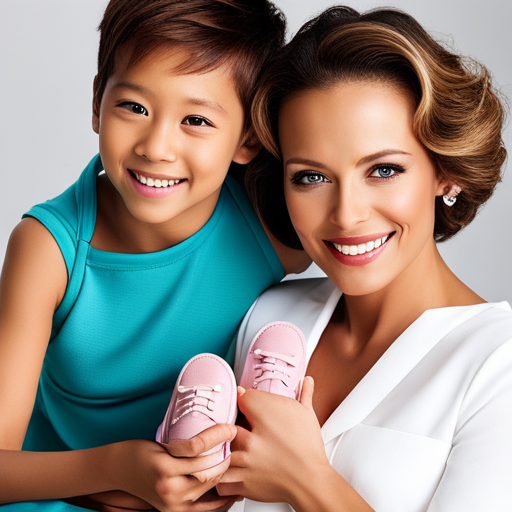
When considering baby shoes, it is essential to look for materials that offer breathability and flexibility to promote healthy foot development. Babies’ feet are still developing, and proper footwear can play a crucial role in their overall foot health. Here are four important factors to consider when choosing baby shoes:
-
Breathability: Look for shoes made from breathable materials such as leather or mesh. This allows air to circulate around the foot, preventing excessive sweating and reducing the risk of foot odor and fungal infections.
-
Flexibility: Opt for shoes that provide flexibility in the sole and upper part, allowing natural foot movement. This helps in the development of foot muscles and balance.
-
Proper fit: Ensure the shoes have enough room for the toes to wiggle and grow. Shoes that are too tight can hinder proper foot development and cause discomfort.
-
Support: Look for shoes with adequate arch and ankle support. This helps in maintaining stability and preventing injuries while your baby is learning to walk.
When it comes to the best brands for baby shoes, popular options include Stride Rite, Pediped, Robeez, and Bobux. These brands are known for their high-quality materials, excellent craftsmanship, and attention to foot health.
When to Start Using Shoes for Walking
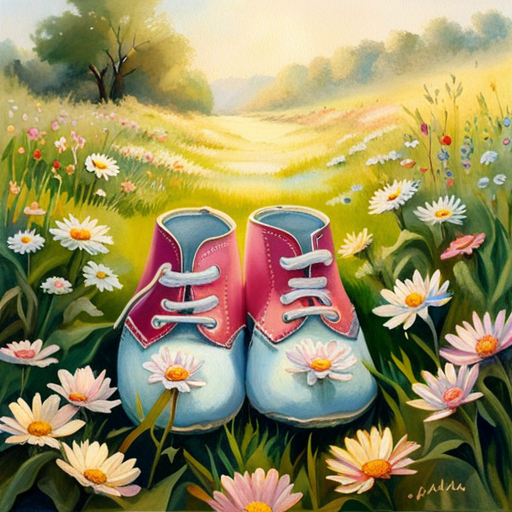
It is important to consider the developmental stage of a child’s feet before introducing shoes for walking. The decision of when to introduce shoes to a child who is learning to walk is a topic of discussion among parents and experts alike. While some believe that shoes should be introduced as soon as the child starts taking their first steps, others argue that barefoot walking is beneficial for the child’s foot development.
Research suggests that allowing babies to walk barefoot can have several benefits. Walking without shoes allows the foot muscles to strengthen naturally and promotes proper foot and arch development. It also enhances proprioception, which is the ability to sense the position and movement of the body. This can improve balance and coordination skills.
However, there are certain situations where shoes may be necessary. In outdoor environments, shoes can provide protection against sharp objects, extreme temperatures, and rough surfaces. Additionally, some parents prefer to use shoes for aesthetic reasons or cultural practices.
Ultimately, the decision of when to introduce shoes for walking should be based on the child’s individual needs and circumstances. Consulting with a pediatrician or a podiatrist can provide valuable guidance in determining the appropriate time to introduce shoes and ensure the child’s foot health is prioritized.
Tips for Finding the Perfect Fit

One helpful tip for finding the perfect fit is to measure the child’s feet regularly and use an adjustable closure system, such as Velcro or laces, to ensure a secure and comfortable fit.
Here are some fitting guidelines and shoe shopping tips to consider:
-
Measure the child’s feet: Children’s feet grow quickly, so it is important to measure their feet regularly to ensure the shoes fit properly. Use a measuring tape or visit a shoe store for accurate measurements.
-
Allow room for growth: Leave about a thumb’s width between the child’s longest toe and the front of the shoe to allow room for growth. This will prevent discomfort and potential foot problems.
-
Consider the shoe’s width: Children’s feet come in different widths, so it is essential to choose shoes that provide enough width to accommodate their feet comfortably. Look for shoes labeled with different width options.
-
Test the fit: Have the child try on the shoes and walk around to ensure they are comfortable and provide enough support. Check for any redness or signs of discomfort, as this may indicate an improper fit.
Supporting Natural Foot Movement
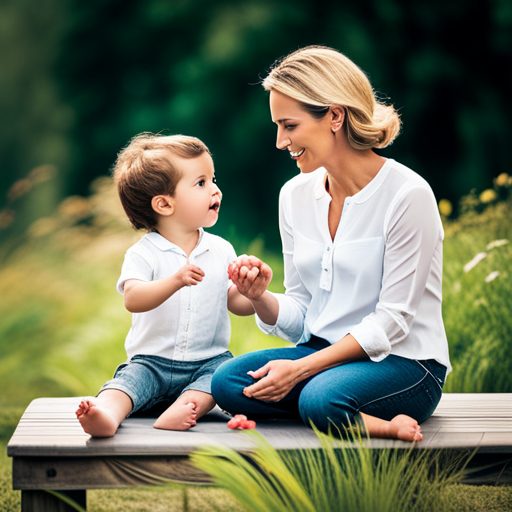
Promoting natural foot movement while walking is essential for maintaining proper alignment and preventing foot-related issues, such as pronation or supination. Therefore, it is important to choose shoes that allow for unrestricted movement and provide adequate support.
Natural foot development begins from infancy, as babies learn to walk and explore their surroundings. During this crucial stage, it is recommended to allow babies to walk barefoot whenever possible. Barefoot walking offers several benefits for natural foot development.
One of the key benefits of barefoot walking is that it allows the foot muscles to strengthen and develop properly. When barefoot, the feet are more engaged and have to work harder to maintain balance and stability. This helps in building strong arches, flexible ankles, and a well-aligned posture. Additionally, barefoot walking enhances proprioception, which is the body’s ability to sense its position and movement in space. By stimulating the nerve endings in the feet, barefoot walking improves coordination and body awareness.
However, it is not always practical or safe for babies to walk barefoot in all environments. In such cases, it is important to choose shoes that mimic the natural foot movement and provide adequate support. Look for shoes that have a flexible sole to allow for unrestricted movement, a wide toe box to allow for natural toe splay, and a secure closure system to keep the shoes in place. These features will promote natural foot development and help prevent foot-related issues in the future.
Ensuring Comfort and Flexibility

When selecting shoes for infants and toddlers, it is crucial to prioritize comfort and flexibility to support their natural foot movement and development. Infants and toddlers have delicate feet that are still developing, and their shoes should not hinder their growth.
Here are four key factors to consider when choosing baby shoes:
-
Comfortable Designs: Baby shoes should have soft and cushioned soles to provide comfort and support. Look for shoes made from breathable materials like leather or mesh that allow the feet to breathe and prevent sweating and discomfort.
-
Flexibility: Babies’ feet are still growing and developing, so it is important to choose shoes that allow for natural foot movement. Look for shoes with a flexible sole that bends easily, allowing the feet to flex and move naturally.
-
Proper Fit: It is essential to choose shoes that fit properly. Avoid shoes that are too tight or too loose, as they can cause discomfort and hinder foot development. Measure your baby’s feet regularly and choose shoes that provide enough room for growth.
-
Promoting Healthy Development: Baby shoes should promote healthy foot development. Look for shoes with a wide toe box that allows the toes to move freely. Avoid shoes with elevated heels or arch support, as they can interfere with natural foot development.
Safety Considerations for Baby Shoes

To ensure the safety of infants and toddlers, it is important to carefully consider the materials and construction of baby shoes, as well as regularly inspect them for any potential hazards. Baby shoes come in a variety of styles, but the most important factor to consider is the comfort and support they provide for a child’s developing feet.
When choosing baby shoes, it is crucial to opt for materials that are soft, breathable, and flexible. This allows for natural movement and prevents any discomfort or irritation. Additionally, the shoes should have a secure closure system, such as Velcro or laces, to keep them in place and prevent tripping hazards.
Regular inspections of baby shoes are essential to identify any signs of wear and tear. Loose threads, broken soles, or sharp edges can pose a risk to a child’s delicate feet. It is also important to ensure that the shoes are the correct size, as ill-fitting shoes can lead to foot problems, such as blisters, calluses, or even deformities.
Caring for Baby Shoes: Cleaning and Maintenance
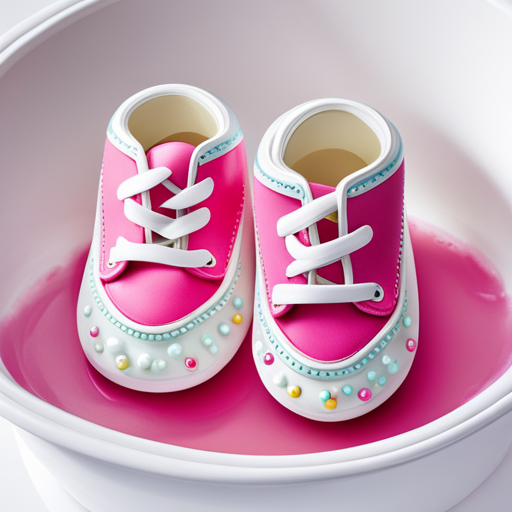
Proper cleaning and maintenance are crucial for preserving the longevity and quality of baby shoes, ensuring their durability and protecting the investment made in providing safe and comfortable footwear for infants and toddlers.
Here are some cleaning tips and storage recommendations to help you take care of your baby’s shoes:
-
Regular cleaning: Use a mild soap or baby-friendly detergent to gently clean the shoes. Avoid harsh chemicals or abrasive cleaners that can damage the material.
-
Handwashing: If the shoes are not machine-washable, handwashing is the safest option. Use a soft brush or cloth to remove any dirt or stains, and air dry them thoroughly.
-
Drying: Avoid direct sunlight or heat sources when drying baby shoes, as they can cause the material to shrink or warp. Instead, let them air dry naturally in a well-ventilated area.
-
Proper storage: Store baby shoes in a cool and dry place, away from direct sunlight. Consider using shoe boxes or fabric bags to protect them from dust and dirt. Keep them in a place where they won’t get crushed or damaged.
Frequently Asked Questions
Can Baby Shoes Help Improve a Baby’s Balance and Walking Abilities?
Baby shoe designs can play a role in improving a baby’s balance and walking abilities. However, it is important to also consider the benefits of barefoot walking, as it allows for better sensory feedback and natural development of foot muscles.
Are There Any Specific Materials or Features to Avoid When Choosing Baby Shoes?
When choosing baby shoes, it is important to avoid harmful materials such as chemicals and toxins. Additionally, certain features, such as non-slip soles and adjustable straps, can enhance comfort and support for the baby’s growing feet.
How Often Should I Measure My Baby’s Feet to Ensure the Right Shoe Size?
Measuring the baby’s feet regularly is crucial to ensure the right shoe size. Due to variations in shoe sizes across brands, accurate measurements are essential for comfort and proper development of the baby’s feet.
Are There Any Safety Standards or Certifications to Look for When Purchasing Baby Shoes?
When purchasing baby shoes, it is important to look for safety standards and certifications. These standards ensure that the shoes meet certain criteria for quality and safety, promoting balance improvement and supporting the child’s walking abilities.
What Are Some Common Mistakes Parents Make When Choosing Baby Shoes?
When choosing baby shoes, parents often overlook important factors, such as the appropriateness of the shoe style for the child’s age and development. This can lead to discomfort, hindered foot growth, and potential foot problems in the future.
Conclusion
In conclusion, choosing the right shoes for your baby is crucial for their foot development and overall comfort. By selecting shoes that support natural foot movement, ensure comfort and flexibility, and meet safety considerations, you can promote healthy growth and prevent potential foot problems.
For example, a case study showed that infants who wore properly fitted shoes with flexible soles had improved balance and stability while learning to walk. It is essential to prioritize your baby’s foot health by investing in appropriate footwear.


